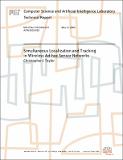| dc.contributor.author | Taylor, Christopher J. | |
| dc.date.accessioned | 2005-12-22T02:30:00Z | |
| dc.date.available | 2005-12-22T02:30:00Z | |
| dc.date.issued | 2005-05-31 | |
| dc.identifier.other | MIT-CSAIL-TR-2005-037 | |
| dc.identifier.other | AITR-2005-003 | |
| dc.identifier.uri | http://hdl.handle.net/1721.1/30549 | |
| dc.description.abstract | In this thesis we present LaSLAT, a sensor network algorithm thatsimultaneously localizes sensors, calibrates sensing hardware, andtracks unconstrained moving targets using only range measurementsbetween the sensors and the target. LaSLAT is based on a Bayesian filter, which updates a probabilitydistribution over the quantities of interest as measurementsarrive. The algorithm is distributable, and requires only a constantamount of space with respect to the number of measurementsincorporated. LaSLAT is easy to adapt to new types of hardware and newphysical environments due to its use of intuitive probabilitydistributions: one adaptation demonstrated in this thesis uses amixture measurement model to detect and compensate for bad acousticrange measurements due to echoes.We also present results from a centralized Java implementation ofLaSLAT on both two- and three-dimensional sensor networks in whichranges are obtained using the Cricket ranging system. LaSLAT is ableto localize sensors to within several centimeters of their groundtruth positions while recovering a range measurement bias for eachsensor and the complete trajectory of the mobile. | |
| dc.format.extent | 69 p. | |
| dc.format.extent | 81859537 bytes | |
| dc.format.extent | 3510560 bytes | |
| dc.format.mimetype | application/postscript | |
| dc.format.mimetype | application/pdf | |
| dc.language.iso | en_US | |
| dc.relation.ispartofseries | Massachusetts Institute of Technology Computer Science and Artificial Intelligence Laboratory | |
| dc.subject | AI | |
| dc.subject | Localization | |
| dc.subject | Target Tracking | |
| dc.subject | Sensor Network | |
| dc.subject | Calibration | |
| dc.title | Simultaneous Localization and Tracking in Wireless Ad-hoc Sensor Networks | |
